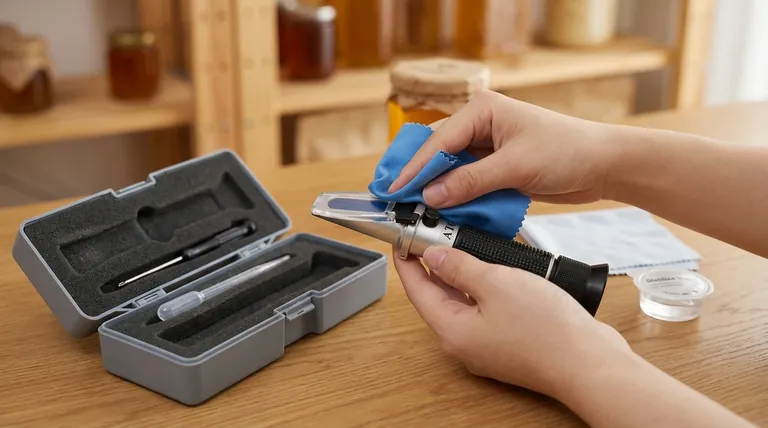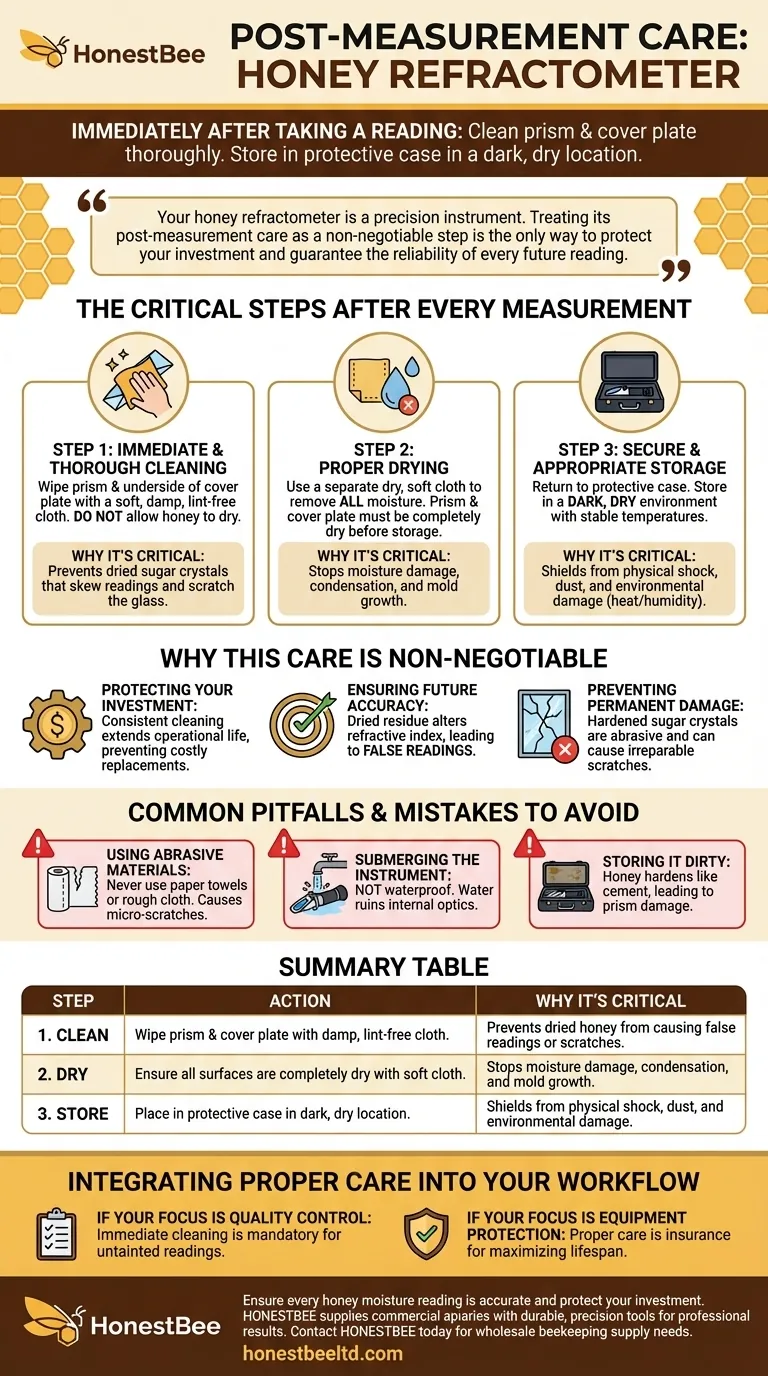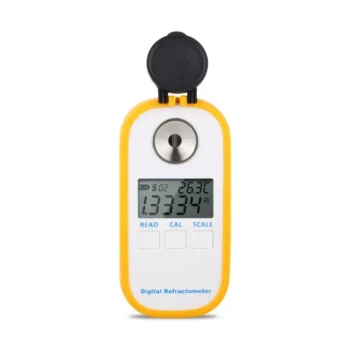Immediately after taking a reading, you must clean the refractometer's prism and cover plate thoroughly with a damp, lint-free cloth. Once dry, it should be placed back in its protective case and stored in a dark, dry location to prevent damage and ensure its accuracy for future use.
Your honey refractometer is a precision instrument. Treating its post-measurement care as a non-negotiable step is the only way to protect your investment and guarantee the reliability of every future reading.

The Critical Steps After Every Measurement
Proper care is not just about cleaning; it's a systematic process that ensures the longevity and accuracy of your device. Each step protects the delicate optical components from damage.
Step 1: Immediate and Thorough Cleaning
The most critical action is to clean the instrument immediately. Do not allow honey to dry on the glass prism.
Use a soft, damp, lint-free cloth to gently wipe all honey residue from the prism surface and the underside of the clear cover plate. This prevents dried sugar crystals from forming, which could skew your next reading or scratch the glass.
Step 2: Proper Drying
After wiping with a damp cloth, use a dry section of the cloth or a separate dry, soft cloth to remove all moisture. The prism and cover plate must be completely dry before storage.
Step 3: Secure and Appropriate Storage
Always return the refractometer to its protective case. This shields it from physical shock and dust.
Store the case in a dark, dry environment with stable temperatures. Storing it in a humid or hot location, like a vehicle or shed, can lead to condensation inside the optics, promote mold growth, or even cause the instrument's body to warp over time.
Why This Post-Measurement Care is Non-Negotiable
Failing to properly clean and store your refractometer directly compromises its core function: providing accurate measurements.
Protecting Your Investment
A refractometer is a scientific tool. Consistent cleaning and careful storage are the simplest and most effective ways to extend its operational life, preventing costly replacements.
Ensuring Future Accuracy
Dried honey residue left on the prism will alter the refractive index for your next sample. This will give you a false reading of the honey's moisture content, defeating the entire purpose of the test.
Preventing Permanent Damage
Hardened sugar crystals are abrasive. If you close the cover plate onto a dirty prism or try to scrape off old residue, you can easily cause permanent scratches on the prism's surface, which will irreparably damage the instrument's accuracy.
Common Pitfalls and Mistakes to Avoid
Even with good intentions, common mistakes can damage your refractometer. Being aware of them is essential for proper maintenance.
Using Abrasive Materials for Cleaning
Never use paper towels, your shirt, or any rough-textured cloth to clean the prism. These materials can cause micro-scratches on the delicate optical glass, which will degrade clarity and accuracy.
Submerging the Instrument in Water
A refractometer is not waterproof. Do not hold it under a running tap or submerge it to clean it. Water can seep into the internal assembly, fog the optics, and ruin the device. A damp cloth is all that is needed.
Storing It Dirty
The single worst mistake is putting the refractometer away without cleaning it. The honey will harden into a cement-like substance that is difficult to remove without damaging the prism.
Integrating Proper Care into Your Workflow
Making these steps a routine habit ensures your equipment is always ready and reliable for its critical task of assessing honey quality.
- If your primary focus is consistent quality control: Treat immediate cleaning as a mandatory part of the measurement process to guarantee every reading is untainted by the last.
- If your primary focus is protecting your equipment: View proper cleaning and storage as the best insurance policy for maximizing your refractometer's lifespan.
Ultimately, professional results depend on disciplined and consistent equipment maintenance.
Summary Table:
| Step | Action | Why It's Critical |
|---|---|---|
| 1. Clean | Wipe prism & cover plate with a damp, lint-free cloth. | Prevents dried honey from causing false readings or scratches. |
| 2. Dry | Ensure all surfaces are completely dry with a soft cloth. | Stops moisture damage, condensation, and mold growth. |
| 3. Store | Place in protective case in a dark, dry location. | Shields from physical shock, dust, and environmental damage. |
Ensure every honey moisture reading is accurate and protect your equipment investment. Proper maintenance is key to quality control. HONESTBEE supplies commercial apiaries and beekeeping equipment distributors with the durable, precision tools needed for professional results. Let us help you equip your operation for success.
Contact HONESTBEE today to discuss your wholesale beekeeping supply needs.
Visual Guide

Related Products
- Precision Honey Refractometer Instrument for Quality Assessment
- Digital Honey Refractometer for Precision Measurement of Optimal Honey Quality
- Modern Honeycomb Pattern Wooden Honey Dipper for Stirring and Drizzling
- HONESTBEE 72 Frame Industrial Electric Honey Extractor for Beekeeping
- HONESTBEE 3-Frame Manual Acrylic Honey Extractor
People Also Ask
- Why is a honey refractometer important for beekeepers? Ensure Quality and Prevent Fermentation
- What are the features of the Standard Refractometer for honey moisture content? Essential Tools for Quality Control
- What are the benefits of using a Pocket Digital Honey Refractometer? Achieve Precision & Speed in Honey Quality Control
- How does a honey refractometer work? Ensure Honey Quality & Harvest Readiness
- What is a honey refractometer? The Essential Tool for Perfect Honey Quality

















